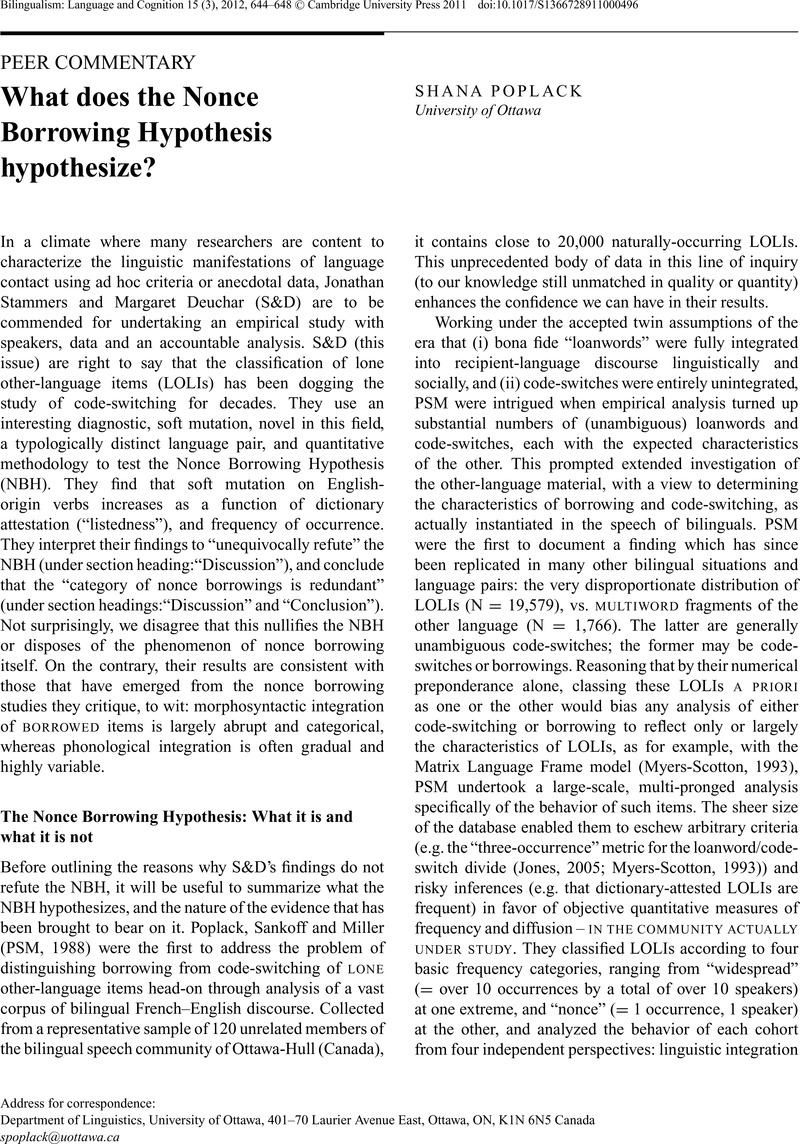Crossref Citations
This article has been cited by the following publications. This list is generated based on data provided by Crossref.
Poplack, Shana
and
Dion, Nathalie
2012.
Myths and facts about loanword development.
Language Variation and Change,
Vol. 24,
Issue. 3,
p.
279.
Yakpo, Kofi
and
Muysken, Pieter
2014.
Pidgins and Creoles beyond Africa-Europe Encounters.
Vol. 47,
Issue. ,
p.
101.
Poplack, Shana
2015.
International Encyclopedia of the Social & Behavioral Sciences.
p.
918.
Aaron, Jessi Elana
2015.
Lone English-origin nouns in Spanish: The precedence of community norms.
International Journal of Bilingualism,
Vol. 19,
Issue. 4,
p.
459.
Cacoullos, Rena Torres
and
Travis, Catherine E.
2015.
Gauging convergence on the ground: Code-switching in the community.
International Journal of Bilingualism,
Vol. 19,
Issue. 4,
p.
365.
Benevento, Nicole M.
and
Dietrich, Amelia J.
2015.
I think, therefore digo yo: Variable position of the 1sg subject pronoun in New Mexican Spanish-English code-switching.
International Journal of Bilingualism,
Vol. 19,
Issue. 4,
p.
407.
Hatoss, Anikó
2016.
Lexical Borrowing in the Speech of First-Generation Hungarian Immigrants in Australia.
Sage Open,
Vol. 6,
Issue. 3,
Karimzad, Farzad
2018.
Optimal choices: Azeri multilingualism in indigenous and diaspora contexts.
International Journal of Bilingualism,
Vol. 22,
Issue. 2,
p.
141.
Vaughan, Jill
2018.
Translanguaging as Everyday Practice.
Vol. 28,
Issue. ,
p.
125.
Bullock, Barbara E.
Serigos, Jacqueline
Toribio, Almeida Jacqueline
and
Wendorf, Arthur
2018.
The challenges and benefits of annotating oral bilingual corpora.
Linguistic Variation,
Vol. 18,
Issue. 1,
p.
100.
INGHAM, RICHARD
2018.
The diffusion of higher-status lexis in medieval England: the role of the clergy.
English Language and Linguistics,
Vol. 22,
Issue. 2,
p.
207.
2018.
Building and Using theSiaradCorpus.
Vol. 81,
Issue. ,
Riksem, Brita Ramsevik
Grimstad, Maren Berg
Lohndal, Terje
and
Åfarli, Tor A.
2019.
Language mixing within verbs and nouns in American Norwegian.
The Journal of Comparative Germanic Linguistics,
Vol. 22,
Issue. 2,
p.
189.
Johns, Michael A
Valdés Kroff, Jorge R
and
Dussias, Paola E
2019.
Mixing things up: How blocking and mixing affect the processing of codemixed sentences.
International Journal of Bilingualism,
Vol. 23,
Issue. 2,
p.
584.
Muldner, Kasia
Hoiting, Leah
Sanger, Leyna
Blumenfeld, Lev
and
Toivonen, Ida
2019.
The phonetics of code-switched vowels.
International Journal of Bilingualism,
Vol. 23,
Issue. 1,
p.
37.
Aabi, Mustapha
2020.
The Syntax of Arabic and French Code Switching in Morocco.
p.
59.
Aabi, Mustapha
2020.
The Syntax of Arabic and French Code Switching in Morocco.
p.
7.
Lee, Seongyong
2020.
Attitudes toward English borrowings in South Korea: a comparative study of university professors and primary/secondary teachers of English.
Asian Englishes,
Vol. 22,
Issue. 3,
p.
238.
Pujol i Campeny, Afra
2021.
Code-switching Llibre dels Fets: Language ideology in the 13th century Crown of Aragon.
Journal of Historical Sociolinguistics,
Vol. 7,
Issue. 1,
p.
87.
Onysko, Alexander
2021.
Constructions in Contact 2.
Vol. 30,
Issue. ,
p.
81.



